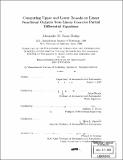Computing upper and lower bounds on linear functional outputs from linear coercive partial differential equations
Author(s)
Sauer-Budge, Alexander M. (Alexander Michael), 1972-
DownloadFull printable version (5.112Mb)
Other Contributors
Massachusetts Institute of Technology. Dept. of Aeronautics and Astronautics.
Advisor
Jamie Peraire.
Terms of use
Metadata
Show full item recordAbstract
Uncertainty about the reliability of numerical approximations frequently undermines the utility of field simulations in the engineering design process: simulations are often not trusted because they lack reliable feedback on accuracy, or are more costly than needed because they are performed with greater fidelity than necessary in an attempt to bolster trust. In addition to devitalized confidence, numerical uncertainty often causes ambiguity about the source of any discrepancies when using simulation results in concert with experimental measurements. Can the discretization error account for the discrepancies, or is the underlying continuum model inadequate? This thesis presents a cost effective method for computing guaranteed upper and lower bounds on the values of linear functional outputs of the exact weak solutions to linear coercive partial differential equations with piecewise polynomial forcing posed on polygonal domains. The method results from exploiting the Lagrangian saddle point property engendered by recasting the output problem as a constrained minimization problem. Localization is achieved by Lagrangian relaxation and the bounds are computed by appeal to a local dual problem. The proposed method computes approximate Lagrange multipliers using traditional finite element discretizations to calculate a primal and an adjoint solution along with well known hybridization techniques to calculate interelement continuity multipliers. At the heart of the method lies a local dual problem by which we transform an infinite-dimensional minimization problem into a finite-dimensional feasibility problem. (cont.) The computed bounds hold uniformly for any level of refinement, and in the asymptotic convergence regime of the finite element method, the bound gap decreases at twice the rate of the H¹-norm measure of the error in the finite element solution. Given a finite element solution and its output adjoint solution, the method can be used to provide a certificate of precision for the output with an asymptotic complexity that is linear in the number of elements in the finite element discretization. The complete procedure computes approximate outputs to a given precision in polynomial time. Local information generated by the procedure can be used as an adaptive meshing indicator. We apply the method to Poisson's equation and the steady-state advection-diffusion-reaction equation.
Description
Thesis (Ph. D.)--Massachusetts Institute of Technology, Dept. of Aeronautics and Astronautics, 2003. Includes bibliographical references (p. 115-123).
Date issued
2003Department
Massachusetts Institute of Technology. Department of Aeronautics and AstronauticsPublisher
Massachusetts Institute of Technology
Keywords
Aeronautics and Astronautics.